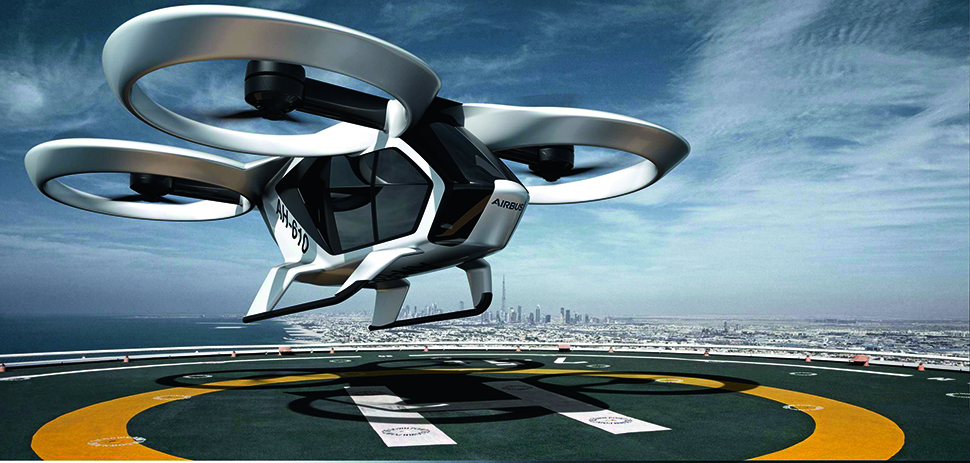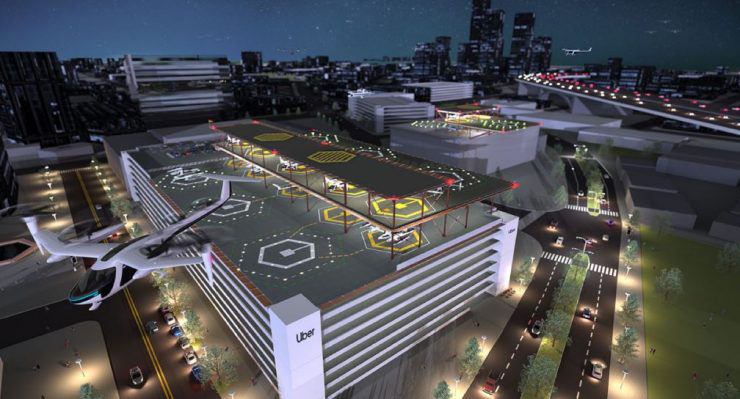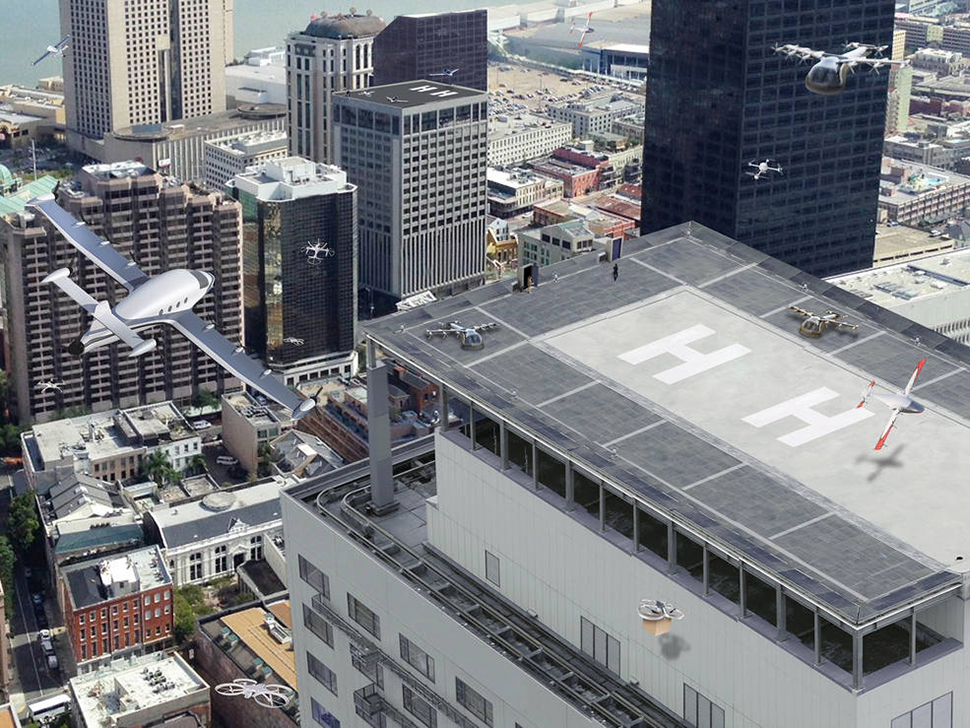The business and general aviation industry is no stranger to innovation and the democratisation of air travel. The very light jet revolution in the mid-2000s is testament to that.
At the time, a host of airframers and operators attempted to shake up the air taxi market with a new breed of small business jets that they hoped would provide low-cost, per-seat, on-demand, point-to-point travel to network of secondary airports. Unfortunately, this niche sector was hit by the advent of the financial crisis and a dearth of funding – but now a bold, new dimension in air travel is gathering pace.
The focus today is on the way we travel across our cities and a new vision for democratised urban air mobility (UAM).
Behind this nascent revolution is the emergence of electric propulsion and improvements in battery technology, which are driving development of a cornucopia of environmentally friendly vehicles, known as electric vertical take-off and landing (eVTOL) aircraft.
According to consultancy Oliver Wyman, there are more than 150 “announced” passenger eVTOL programmes in various stages of development, with between $1-2 billion of investment already “committed” to these projects to date.
Those developing eVTOL concepts range from start-ups such as Germany’s Volcopter and China’s eHang to the world's most powerful airframers including Airbus, Bell, Boeing, and Embraer. All these manufacturers have formed dedicated divisions, subsidiaries, or teams looking at urban air mobility solutions.
Of course, the idea of VTOL aircraft flying around cities is not new. Helicopters have been central to urban transport infrastructure for decades in their role as passenger carriers, air ambulances and news gatherers. What is new, however, is the overwhelming desire to create an autonomous aircraft with a low noise and carbon footprint, so they can be deployed in large numbers to help alleviate congestion in the world’s most traffic-heavy conurbations.
Harini Kulatunga, head of unmanned aerial mobility solutions at Airbus – developer of Vahana – says increasing urbanisation and road congestion are key main drivers for these new methods of travel. "By 2030, 60% of the world's population will be urban,” she says. “To help cities cope with this massive population growth, transport solutions need to safely and sustainably improve the way people get from A to B. UAM enhances the coverage and reach of the transportation system with minimal land impact [and] sustainable city development becomes possible."
German consultancy Roland Berger agrees. In a recent study on urban air mobility, it declared the time “is now ripe for the emergence of UAM as a new industry”, and predicts a fleet of no less than 100,000 passenger drones in service worldwide by 2050.
“The advances in electric propulsion, autonomous flight technology and 5G communication networks will spawn on-demand air taxi services, scheduled airport shuttles and intercity flights,” says the report.
It describes eVTOLs as “a third dimension to the urban transportation matrix” and “an attractive solution” for areas where “merely increasing two-dimensional capacity would in no way ease the existing traffic situation.”
The first vehicles are expected to be sold for private use in 2021, leading to the initial commercial operations as early as 2022.
The industry has bold ambitions to develop this nascent sector, but is under no illusion about the challenges ahead. Speakers at the global urban air mobility summit (GUAS) at Farnborough, UK in early September were asked what they considered to be the biggest obstacle to the sector taking off. The near-unanimous answer was “public acceptance”.
Guillaume Thibault, partner transportation practice with Oliver Wyman, believes the introduction of autonomous eVTOLs in particular will not be possible for some time due to a lack of trust in the new technology. He cites a recent UBS report in which only 17% of 8,000 people surveyed said they would be prepared to travel in a pilotless aircraft. “It’s a potentially long journey to automation, which will come with the rise of the new digital friendly generation,” says Thibault.
His view is supported by Pippa Malmgren, co-founder of unmanned aerial vehicles manufacturer H Robotics. She compares public discomfort with autonomous aircraft to the advent of self-driving cars: “Many thousands are killed by cars each year, and that’s generally accepted by the public; but introduce automation to the vehicle and it’s a different response.”
Malmgren says to gain the public’s trust in pilotless aircraft, industry must demonstrate the vital role that UAVs – of which eVTOLs are after all only an extension – play in everyday lives, and illustrate the important developments in this technology. “It’s about education and reassurance”, she says. “[We need to] fly UAVs for a long time on vital missions, such as cargo delivery, organ transport, patrol and para-public services, just to prove how safe and valuable they are.”
For Jay Merkle, executive director for the office of unmanned aircraft systems with the US Federal Aviation Administration, the issue boils down the public’s long-held unease with aircraft operations. Like Malmgren he points a high public tolerance of road accidents, but little or no tolerance towards air traffic accidents: “The safety record of aviation is very high, and yet many people still have a fear of flying.”

CityAirbus eyes surging urban population growth
Airbus
OUTREACH CAMPAIGNS
The FAA is making bold steps to garner “community acceptance” of UAV operations, which it describes as “the fastest-growing segment of aviation”. The agency is working on two initiatives with local governments and industry partners including NASA, which it hopes will lay the foundations for a fully-fledged UAM network. The programmes are designed to promote the “safe integration of drones” into the national airspace, to craft new rules, policy and guidance that support “more complex low-altitude operations”, and to make the “routine use of UAVs a reality”.
“The state, local and tribal governments are working closely with their industry partners to tackle challenges to safe and secure integration, including night operations, flights over people, operations beyond the pilot's line of sight, package delivery, detect-and-avoid technologies and the reliability and security of data links between pilot and aircraft,” the FAA says.
Despite the advances in electric technology, noise will also be a major consideration if public support for UAM services is to be gained. At the Farnborough GUAS conference, Richard Matthews, a director at UK company Arup Acoustics emphasised: “Ignore the concerns about noise at your peril”.
He cited as an example the strength of feeling in the 1970s against Concorde’s introduction. The anti-Concorde protesters successfully challenged the idea of supersonic passenger transport, and severely curtailed the airliner’s commercial prospects.
"eVTOL craft will be a lot quieter than Concorde but they will be far from silent, and the dream is to operate them in an urban setting close to millions of people. Noise will be an issue that needs to be addressed," says Mathews.
Arup has developed technology that creates the “real noise” environment produced by different modes of transport within a given soundscape, such as an airport and its surrounding area. "Our SoundLab has been used by HS2 and London Heathrow to accurately simulate the noise of these future developments in a variety of environments," Mathews says. It is not used as a "brain-washing tool", he says, "but as an accurate demonstration so that the anti-lobby and pro-lobby can come to a common agreement on the real issues and focus on areas of mitigation that are genuinely required".
Tolerance thresholds for noise and nuisance are subjective. Getting the public to embrace UAM will be easier if these new, time-saving, innovative platforms are available to the masses, rather than a privileged few.
“Focusing solely on the benefits of a few wealthy individuals – much as conventional VTOL does today – will prevent urban air mobility from realising its full potential,” says Roland Berger. The obvious benefits of speed and economy, together with a safe, enjoyable and environmentally green experience and integrated mobility must be clearly demonstrated if a broader public, as well as city authorities, are to accept the potential downside created by the visual and noise pollution caused by passenger drones,” the consultancy adds.
Transportation services company Uber aims to do just that. The company believes it can leverage its ground network of some 100 million monthly platform users and move them into the air. Uber has partnered with six eVTOL developers – Bell, Boeing, EmbraerX, Karem Aircraft Jaunt and Pipistrel – that it hopes will compose a broad fleet of “quiet, safe, efficient aircraft designs” for what its brands Uber Air.
“We are working very hard to develop a platform for an urban air service that will be part of our full transportation offering [including bikes, cars and scooters],” says Francois Sillion, director of Uber’s Paris-based advanced technology research centre.
“With two billion more people expected to be living in cities by 2050, we need to take people off the ground and improve their quality of life.”
Sillion expects UAM aircraft to be used as a combined mode of transport. The aircraft will operate via a network of Uber-branded “Skyports”, from which customers will arrive and depart by another means of transport, ideally in the Uber family, he says. The entire journey will be booked via a single app and will seamless and user-friendly.
Experience and price are key to Uber Air’s acceptance by the public. “We are looking at price per mile for each passenger that is comparable with UberX [the company’s high-end ridesharing offering]”, says Sillion. The greater the load on each aircraft, the cheaper the flight.
Uber plans to begin commercial operations with the first aircraft in three pilot cities – Dallas, Los Angeles and Melbourne, Australia – by 2023. It is now establishing partnerships with real-estate developers to create the ground infrastructure. “Our aim is to demonstrate that these different aircraft models can operate on the Uber platform and that all the elements are working together,” Sillion says.
As part of an extensive launch programme, Uber in July started helicopter services in New York City with its operator partner HeliFlite. “Uber Copter is testing the multimodal experience of ground and air transport,” says Sillion.

Uber hopes to transition existing customers to the air
Uber
ROUTE OPTIMISATION
The company is rolling out its Elevate Cloud Services system to support all aspects of flight operations. It is also developing networks of so-called “Skylines” in the cities it plans to serve. These will determine which route is optimum at any given time for a specific flight, based on factors such as air traffic density, terrain and “community acceptance” issues.
For Duncan Walker, co-founder and managing director of ground infrastructure developer Skyports, gaining public “acceptance” for UAM services will be tougher in many western countries, due to their “higher tolerance for risk”.
The UK start-up is preparing to open what Walker describes as “the world’s first vertiport for eVTOL aircraft” in Singapore on 21 October. Live flight trials will begin soon after with Volocopter’s 2X prototype. Skyports has joined forces with the German UAM developer to launch commercial services in the city state from 2022, using the latest version of its two-seat air taxi, dubbed VoloCity. The all-electric multicopter is currently in development and is scheduled to make its first flight within 18 months.
Walker says Singapore has been very supportive of the initiative from the start, and has “expedited the approval process” for building the vertiport. “We’ve had good political engagement,” he says. “Singapore is forward-thinking and prides itself on the adoption of new technology.”
The trials with Volocopter with give both companies “vital public feedback” on urban aviation for the first time – testing to see where the pinch-points are, how swiftly passengers can be moved through the security process, and how well-received this type of operation is. “Then we will work hard to turn this proof-of-concept into a reality,” Walker says.
Skyports has invited the “great and good” from a number Asian countries, including Japan, to witness the trials in the hope of securing what Walker calls “other first mover markets”.
The problem, he says, is that “the regulatory landscape for an urban air mobility ground infrastructure is generally a complete mess”. He cites a lack of commonality in regulations and a reluctance in some countries to address these issues. “The locations we have picked out for development have been driven more by politics, in terms of getting the right support from the authorities, rather than just economics,” says Walker.
The industry is aiming to develop a set of rules for the land-based infrastructure around new vertiport designs. “We sit on 14 bodies globally which are aiming to put rules in place, but these need to be harmonised,” he says.
He says the industry “must make better progress” in promoting the benefits of UAM to governments and regulators. “With their approval we can achieve scalability worldwide, and bring down the price of UAM transport so it can be accessed by a broad base of customers." The vertiport is a big part of the user experience, he adds, and “getting this right is so important”.
Roland Berger agrees. “It is one thing to build suitable and reliable vehicles, but it is entirely another thing to establish the infrastructure without which the vehicles themselves cannot operate,” it says.
eVTOL landing sites, charging infrastructures and maintenance facilities must all be set up as key enablers for successful operational business models, Roland Berger adds: “Failure to do so will create bottlenecks that could nip the nascent UAM market in the bud and stunt its growth.”
ICAO’s heliport standards are the starting point for these new vertiport regulations, which will be adapted to local regulations.
UAM and helicopter ecosystems are very different, Walker says. To make a viable business model from eVTOL operations there must be “volume, high utilisation and charging points”. London Battersea heliport for example, the main landing site for helicopters in London, has 22,000 movements a year. A fully-functioning vertiport will have two to three take off and landings every few minutes, says Walker.
The pinch point for a vertiport is the number of gates at the site. “You have to be able to get the aircraft and passengers off the landing pad, swiftly and safely, to ensure seamless operation,” Walker says.
Charging is also an issue given the limitations of battery power, with “fast charging” technology not yet mature enough to solve the problem.
As a short-term solution, Walker recommends what he calls “battery swapping” – replacing a flat battery with a fully-charged one, and then recharging the unit to be used with another aircraft. “It’s a good option to start with, as it will enable a swifter route to market,” says Walker.
But battery swapping is not ideal in the medium to long term, he says, because the number and variety of aircraft with different batteries will increase over time leading to structural and space constraints at the vertiport. “With a potentially large network of landing sites, it could prove tricky to track the batteries through the supply chain,” Walker says.
SkyPorts is developing a number of vertiport designs that can be expanded in stages. “Infrastructure is capital intensive, so a vertiport must be modular and scalable. Start small with a modest presence, and as business grows with public acceptance, you can bolt on additional infrastructure,” he says.

NASA and regulators hope to build community acceptance of operations
NASA
2019NBAA
Read all the latest news and information from the 2019 NBAA show on our dedicated page


























